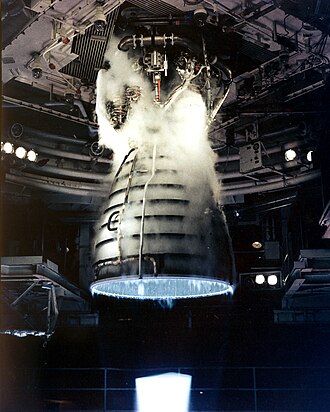Spacecraft propulsion






Spacecraft propulsion is a branch of aerospace engineering that deals with the processes and technologies used to propel spacecraft and satellites through space. The primary goal of spacecraft propulsion systems is to provide thrust to overcome the gravitational pull of the Earth or other celestial bodies, and to maneuver the spacecraft within or outside the Earth's orbit for various missions, including satellite deployment, interplanetary travel, and deep space exploration.
Types of Spacecraft Propulsion Systems[edit]
Spacecraft propulsion systems can be broadly classified into two categories: chemical propulsion and electric propulsion.
Chemical Propulsion[edit]
Chemical propulsion systems use the reaction of chemical propellants (fuel and oxidizer) to produce thrust. This is the most traditional form of propulsion and includes liquid rocket engines and solid rocket motors. Chemical propulsion provides high thrust and is typically used for launching spacecraft from Earth's surface and major orbital maneuvers.
Liquid Rocket Engines[edit]
Liquid rocket engines use liquid propellants that are fed into a combustion chamber, where they are mixed and ignited. These engines are capable of being throttled and shut down, which offers flexibility during missions.
Solid Rocket Motors[edit]
Solid rocket motors contain a solid propellant mixture that ignites to produce thrust. These motors are simpler and more reliable than liquid engines but cannot be throttled or shut down once ignited.
Electric Propulsion[edit]
Electric propulsion systems, also known as ion or plasma engines, use electrical energy to accelerate ions to high speeds. These systems offer higher efficiency and longer operation times but produce lower thrust compared to chemical systems. Electric propulsion is ideal for deep space missions and satellite station-keeping.
Ion Thrusters[edit]
Ion thrusters accelerate ions using electricity to create thrust. The ions are generated in an ionization chamber and are accelerated by electric fields.
Hall Effect Thrusters[edit]
Hall Effect Thrusters are a type of ion thruster where the acceleration of the ions is achieved through a magnetic field. These thrusters are known for their efficiency and are commonly used in satellite propulsion.
Selection of Propulsion Systems[edit]
The selection of a propulsion system for a spacecraft depends on the mission requirements, including the destination, duration, and payload. Chemical propulsion is preferred for missions requiring high thrust, such as launches and major orbital changes. Electric propulsion is chosen for missions where efficiency and long-duration operation are critical, such as station-keeping and deep space exploration.
Future Developments[edit]
Research in spacecraft propulsion continues to advance, with the aim of developing more efficient and powerful propulsion systems. Future technologies may include nuclear propulsion, which could significantly reduce travel time for interplanetary missions, and advanced electric propulsion systems with higher thrust capabilities.
Ad. Transform your life with W8MD's Budget GLP-1 injections from $75


W8MD offers a medical weight loss program to lose weight in Philadelphia. Our physician-supervised medical weight loss provides:
- Weight loss injections in NYC (generic and brand names):
- Zepbound / Mounjaro, Wegovy / Ozempic, Saxenda
- Most insurances accepted or discounted self-pay rates. We will obtain insurance prior authorizations if needed.
- Generic GLP1 weight loss injections from $75 for the starting dose.
- Also offer prescription weight loss medications including Phentermine, Qsymia, Diethylpropion, Contrave etc.
NYC weight loss doctor appointmentsNYC weight loss doctor appointments
Start your NYC weight loss journey today at our NYC medical weight loss and Philadelphia medical weight loss clinics.
- Call 718-946-5500 to lose weight in NYC or for medical weight loss in Philadelphia 215-676-2334.
- Tags:NYC medical weight loss, Philadelphia lose weight Zepbound NYC, Budget GLP1 weight loss injections, Wegovy Philadelphia, Wegovy NYC, Philadelphia medical weight loss, Brookly weight loss and Wegovy NYC
|
WikiMD's Wellness Encyclopedia |
| Let Food Be Thy Medicine Medicine Thy Food - Hippocrates |
Medical Disclaimer: WikiMD is not a substitute for professional medical advice. The information on WikiMD is provided as an information resource only, may be incorrect, outdated or misleading, and is not to be used or relied on for any diagnostic or treatment purposes. Please consult your health care provider before making any healthcare decisions or for guidance about a specific medical condition. WikiMD expressly disclaims responsibility, and shall have no liability, for any damages, loss, injury, or liability whatsoever suffered as a result of your reliance on the information contained in this site. By visiting this site you agree to the foregoing terms and conditions, which may from time to time be changed or supplemented by WikiMD. If you do not agree to the foregoing terms and conditions, you should not enter or use this site. See full disclaimer.
Credits:Most images are courtesy of Wikimedia commons, and templates, categories Wikipedia, licensed under CC BY SA or similar.
Translate this page: - East Asian
中文,
日本,
한국어,
South Asian
हिन्दी,
தமிழ்,
తెలుగు,
Urdu,
ಕನ್ನಡ,
Southeast Asian
Indonesian,
Vietnamese,
Thai,
မြန်မာဘာသာ,
বাংলা
European
español,
Deutsch,
français,
Greek,
português do Brasil,
polski,
română,
русский,
Nederlands,
norsk,
svenska,
suomi,
Italian
Middle Eastern & African
عربى,
Turkish,
Persian,
Hebrew,
Afrikaans,
isiZulu,
Kiswahili,
Other
Bulgarian,
Hungarian,
Czech,
Swedish,
മലയാളം,
मराठी,
ਪੰਜਾਬੀ,
ગુજરાતી,
Portuguese,
Ukrainian
